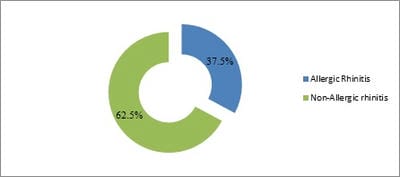The diagnostic utility of Serum IgE and Absolute eosinophil count in cases of Allergic Rhinitis
Agrawal A.1, Chandan RH.2*
DOI: https://doi.org/10.17511/jopm.2020.i01.09
1 Akanksha Agrawal, Senior Resident, Department of Pathology, Karnataka Institute of Medical Sciences, Hubli, Karnataka, India.
2* Rajesh H Chandan, Professor, Department of Pathology, Karnataka Institute of Medical Sciences, Hubli, Karnataka, India.
Introduction: Allergic rhinitis is the commonest allergic disease in India. Eosinophils have been long associated with allergies. Serum IgE levels are also used as a parameter to support the diagnosis of the same. Both absolute eosinophil count (AEC) and serum IgE are a part of basic investigation panel for allergies and are known to be positively related with it. Thus, this study was taken up to determine the diagnostic utility of Serum IgE and absolute eosinophil count in cases of Allergic rhinitis. Methodology: This was a two-year prospective study conducted on 105 cases, clinically diagnosed as allergic rhinitis. Absolute eosinophil count and total serum IgE were recorded for all the cases. Diagnostic utility of each parameter was determined using appropriate statistical tests. Results were tabulated and assessed. Results: Among 105cases, 44.8% were females and 55.2% were males, with mean age of 29.8years. Peripheral blood eosinophils >6% were seen in 42% cases. Of the total cases, Absolute eosinophil count was increased>450cells/cu mm in 49 (46.6%) cases and Serum IgE was elevated >120IU/ml in 73(69.5%) cases. Both AEC and Serum IgE together were raised only in 39(37.1%) cases. Conclusion: Thirty-nine (37.1%) cases showed simultaneous increase in AEC and Serum IgE. The outcomes of both tests when considered together did not significantly affect the diagnosis of Allergic rhinitis. However, individually, 49 (46.6%) cases had a high absolute eosinophil count and Serum IgE was raised in 73(69.5%) cases. Although not significant, testing for Serum IgE levels were found to be more accurate with a better diagnostic utility.
Keywords: Allergic Rhinitis, Absolute Eosinophil Count, Serum IgE
| Corresponding Author | How to Cite this Article | To Browse |
|---|---|---|
| , Professor, Department of Pathology, Karnataka Institute of Medical Sciences, Hubli, Karnataka, India. Email: |
Agrawal A, Chandan RH. The diagnostic utility of Serum IgE and Absolute eosinophil count in cases of Allergic Rhinitis. Trop J Pathol Microbiol. 2020;6(1):58-62. Available From https://pathology.medresearch.in/index.php/jopm/article/view/402 |


 ©
© 